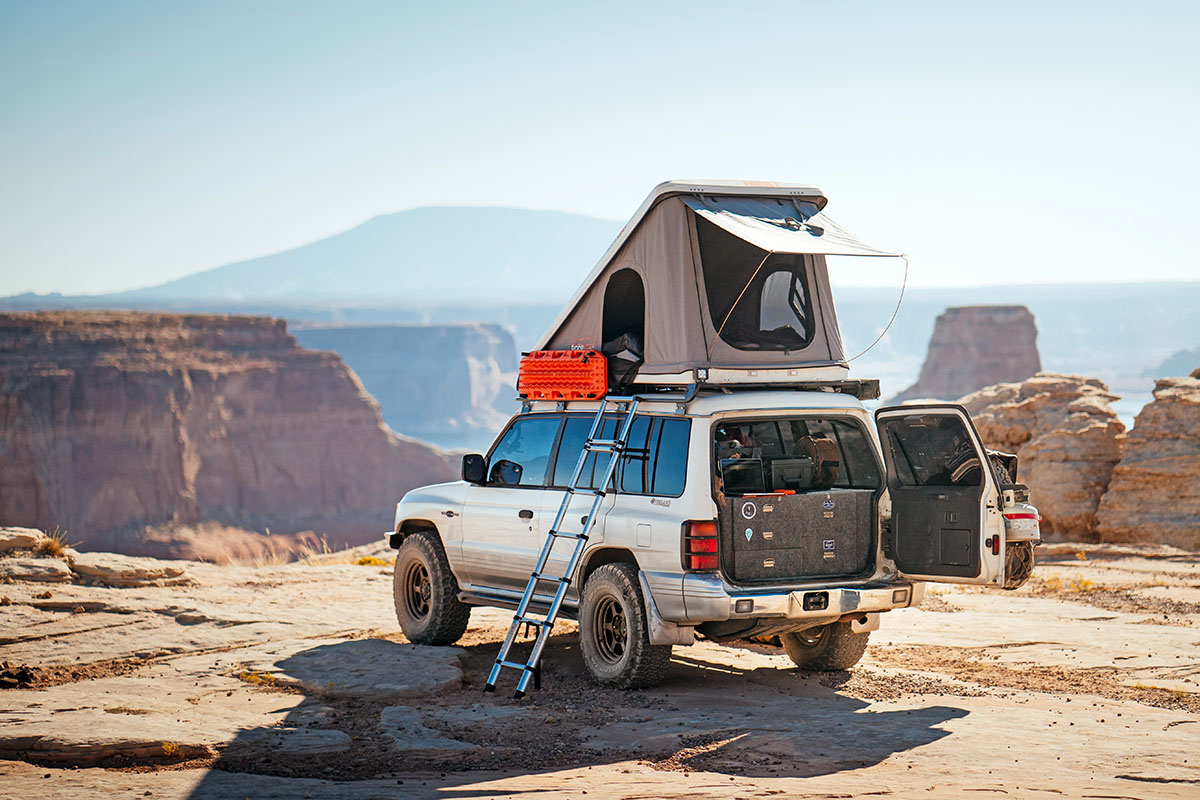

Rooftop tents have never been more popular, and it’s easy to see why. Rather than having to meticulously stake out and assemble your tent and sleep system once you arrive at camp, rooftop designs pop up or fold out from the top of your vehicle and come equipped with comfortable mattresses for a good night’s sleep. Designs range from budget-friendly softshells to premium hardshell and overlanding models built to take a licking, but all of the rooftop tents here keep you off the ground, are relatively easy to set up and stow, and free up valuable storage space in your vehicle. Below are our favorite 15 rooftop tents of 2025. For more background information, see our comparison table, info about our testing process, and buying advice below the picks.
Editor's note: This guide was updated on September 12, 2025, to add the James Baroud Odyssey to our lineup and include new photos from recent testing trips. We also combed through the guide to ensure prices, colorways, and all other information were current at the time of publishing.
 Category: Hardshell
Category: Hardshell
Floor area: 42 sq. ft.
Peak height: 50 in.
Available Capacities: 2+, 3+
What we like: The spaciousness of a softshell tent with the durability and quick setup of a hardshell.
What we don’t: Overkill for solo travelers and even most couples.
If you’re in the market for a high-end rooftop tent that’s built to last, you’ll likely settle on a hardshell design. Compared to softshell tents, hardshells are more durable, offer better weather protection, and are easier to set up (we cover more of the differences in our buying advice below). They also give you the versatility of adding a solar panel or roof rack on top, which is worth the added investment for many. Most hardshell tents feature pop-up or clamshell designs that limit the bed to the size of the footprint, but premium fold-out designs like the Condor 2 XL Air increase sleeping space considerably with an extended platform and mattress (for reference, interior dimensions measure 89 x 68 in., which is longer and wider than a queen-size bed and can comfortably fit three to four sleepers).
iKamper was the original innovator of the fold-out hardshell (see the Skycamp 3.0 below), but Roofnest's take on the concept offers similar quality at a better price. The Condor 2 XL Air also features a significantly shorter footprint (great for accessing the rear hatch on smaller vehicles), and its crossbar compatibility is ideal for those who like to bring along extra toys. The Condor is also available in a smaller two-person version (29.8 sq. ft.) and the rugged Condor Overland 2, which features a durable aluminum shell (compared to the standard Condor's ABS plastic with ruggedized coating). But the XL here is the best all-rounder for couples or small families, and its combination of durability, convenience, comfort, and value is hard to beat. Note: We tested the previous iteration of the Condor 2 for this round-up before it was updated to the Condor 2 "Air". We predict that performance will be largely similar between the two models, but there are a few key differences, including sleek new styling, improved awnings, a drop in weight by 10 pounds, and a new "Rest EZ Sleep System" with 100% bamboo sheets and a blanket.
Read more: Rooftnest Condor 2 review (previous version)
See the Roofnest Condor XL Air

 Category: Softshell
Category: Softshell
Floor area: 35.1 sq. ft.
Peak height: 51 in.
Available Capacities: 2+, 3+
What we like: A functional design at a very reasonable price point.
What we don’t: Not as user-friendly or durable as more premium softshell tents.
Priced at $1,500 and often found on sale, the Smittybilt Gen2 Overlander is one of the best values on the market and our favorite budget-oriented rooftop tent design. Despite undercutting most of the competition by a sizeable amount, the Overlander is still an excellent overall performer: Like the Approach below, the Smittybilt sleeps two or three campers comfortably and uses heavy-duty materials such as a 600-denier ripstop polyester, 420-denier rainfly, and robust zippers and fly poles. It also has functional features, including an integrated LED lighting strip and a rubber boot bag to hang your dirty shoes outside the tent (a feature we really love). Added up, you'd be hard-pressed to find a more complete design for less money.
The Gen2 Overlander addresses some of the complaints we had about the prior version. It has a telescoping ladder (the previous version's ladder was prone to sticking and difficult to attach), the cover attaches with mostly a zipper instead of Velcro, and the rainfly is larger and has clear skylights so you can still see outside on rainy days (the Gen1 rainfly had no windows). While assembly and mounting aren't quite as streamlined as some of the more premium models in our lineup (the tent comes without the rails on the underside already attached), we honestly can't complain when considering how much tent you're getting for the price. All told, if you don't mind a bit more work up front, this is a solid choice from a reputable brand in the RTT world.
See the Smittybilt Gen2 Overlander
 Category: Softshell
Category: Softshell
Floor area: 33.6 sq. ft.
Peak height: 40.2 in.
Available Capacities: 2, 2+, 3+
What we like: Modern shape and design offer great livability and interior space.
What we don’t: You’ll get better weather protection and durability with a hardshell tent.
Thule offers a well-rounded rooftop tent lineup ranging from affordable entry-level models to burly designs built for overlanding. Their Explorer Kukenam was our favorite softshell tent for years running and was replaced with the modernized Approach. The Approach is a feat of innovation, with a unique shape and large panoramic windows that make it a very fun and roomy place to be. Like the prior model, it features a UV- and mold-resistant 600-denier ripstop body fabric with a retractable rain cover, and lockable mounting brackets that are easy to install and help to prevent theft. Finally, the Approach is available at many retailers (just pop into your local REI Co-op or vehicle accessory store), and it pairs seamlessly with Thule racks.
Thule is the historical giant of rooftop tents, but the competition is stronger than ever in 2025. As we mentioned above, many campers will opt for a hardshell for superior durability, weather protection, convenience, and versatility (Thule’s Basin below falls within this category). And stacked up against other softshells, the Approach isn't particularly cheap, which is one of the major selling points of going the softshell route to begin with. That said, the Approach's price actually went down last year, making the medium-sized option a lot less than the top-ranked Condor, and the sub-three-minute setup is particularly user-friendly and straightforward. All told, for a long-lasting, reliable rooftop tent that won't break the bank, the Approach is all most recreational campers need.
See the Thule Approach Medium

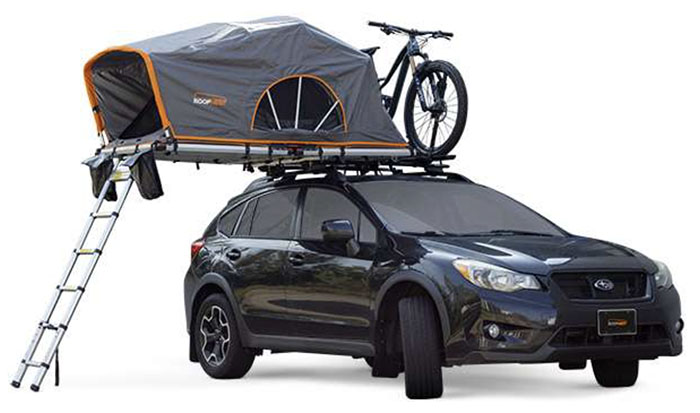 Category: Softshell
Category: Softshell
Floor area: 23.9 sq. ft.
Peak height: 36 in.
Available Capacities: 2, 2+
What we like: Lightweight, easy to move, and affordable.
What we don’t: Not as spacious as other softshell models.
Roofnest's Condor above is our favorite overall rooftop tent of the year, but for quick trips, smaller cars, and solo travelers, the Meadowlark is a viable alternative. The only softshell in Roofnest's lineup, the Meadowlark was purpose-built for minimalism and affordability. Its 90-pound build makes it reasonable for small cars and is fairly easy for two people to maneuver, and the price tag is among the lowest here. Add in Roofnest's reliable build quality, a refined pitch that sets up in less than a minute, and add-ons like a telescoping ladder, two interior pockets, and interior LED light, and the Meadowlark is a great choice for those looking for a rooftop sleep without the headaches of bad gas mileage or a weighed-down car.
Stacked up against the budget-friendly Smittybilt above, the Meadowlark costs more (than MSRP) and offers significantly less living space (by a whopping 13 sq. ft.). But Roofnest's build quality is superior overall, and most recreational campers will value the simplicity of the Meadowlark over the Smittybilt's more overlanding-focused design—not to mention its lighter and much more compact packed size. The Meadowlark's 43 x 80-inch floor plan is cozy for two and best for sleepers under 6 feet tall. Other designs in this lightweight and compact category include the innovative (and inflatable) Dometic TRT 140 Air ($2,500; 104 lb.) and Front Runner's Roof Top Tent below ($1,209; 93 lb.), but neither can match the Roofnest's quality and ease of use.
See the Roofnest Meadowlark
 Category: Hardshell
Category: Hardshell
Floor area: 26.1 sq. ft.
Peak height: 58 in.
Available Capacities: 2, 2+
What we like: Lightweight shell, low-profile design, and can accommodate cargo on top.
What we don’t: On the heavier side (though lighter than the last version by 20 lb.).
At only 8 inches tall when closed, Roofnest's Falcon 3 Evo Air isn't the slimmest model on our list—that title goes to the iKamper BDV below—but it's darn close. The aerodynamic shape helps improve gas mileage and reduce wind noise, which can make a big difference during a long drive. But the low-profile design isn't the only thing we love about the Falcon: It can accommodate a standard roof rack on top, meaning you don't have to choose between your tent and your surfboard, bike, or other external cargo. Also, despite the slim design, it opens to a generous 58-inch peak height—one of the tallest here—and offers great protection from the elements (just be sure to face the shell against the wind). The Falcon 3 also has a blackout coating to keep the interior dark (until you open one of the two side windows), a moon roof, LED strip lights, and HVAC ports.
The Falcon 3 Evo makes several key improvements over the Falcon 2 that directly address some of the complaints we and many other folks had with the past-generation model. The latest 3 Evo "Air" is 1.5 is a whopping 10 pounds lighter than the previous Falcon 3, and higher than the Falcon 2. This bit of extra height means that light bedding can be left in the tent when you pack up—something the Falcon 2 couldn't accommodate. The 3 Evo also has 2 inches less headroom and is shorter than the 2, yet the updated design provides 38% more interior space. If the loss of length is concerning to you, the Falcon 3 Evo XL is 5 inches longer and 10 inches wider than the base model, though it will cost you more and is heavier. Note: We tested the previous iteration of the Falcon 3 for this round-up before it was updated to the Falcon 3 "Air". We predict that performance will be largely similar between the two models, but there are a few key differences including sleek new styling, improved awnings, a drop in weight by 10 pounds, and a new "Rest EZ Sleep System" with sheets and a blanket.
See the Roofnest Falcon 3 Evo Air
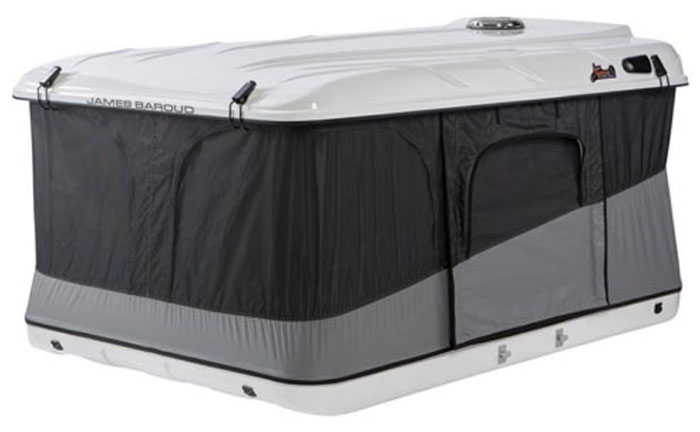 Category: Hardshell
Category: Hardshell
Floor area: 29.8 sq. ft.
Peak height: 39 in.
Available Capacities: 2, 2+, 3
What we like: Insanely high quality and premium feature set, including a solar-powered fan.
What we don’t: Expensive.
If you're looking for the Mercedes Benz of rooftop tents, James Baroud is your answer. For over 30 years, this Portugal-based company has designed and produced rooftop tents that top the charts in terms of comfort, stability, and bombproof weather protection, and quality design. With standard features including a solar-powered ventilation fan, gas-strut assisted opening (setup takes 30 seconds), and LED lighting, even James Baroud's base models are a cut above the rest.
The James Baroud Evasion is a pop-top hardshell, similar to models like the Thule Basin. You'll pay a pretty penny for this tent, but it's more suitable for the rigors of overlanding than most—all James Baroud models are made with the highest quality materials and are tested in 60 mph winds (unlike most hardshell tents, they're also compatible with an enclosed awning). Most rooftop campers can get away with a cheaper tent (or pay a similar price for a roomier model), but for brand-name bragging rights and the classiest tent on the block, you simply can't beat James Baroud. These tents can be hard to find (they are sold through their website and through a few other retailers), but it doesn't hurt that they all come with a reliable 5-year warranty.
See the James Baroud Evasion
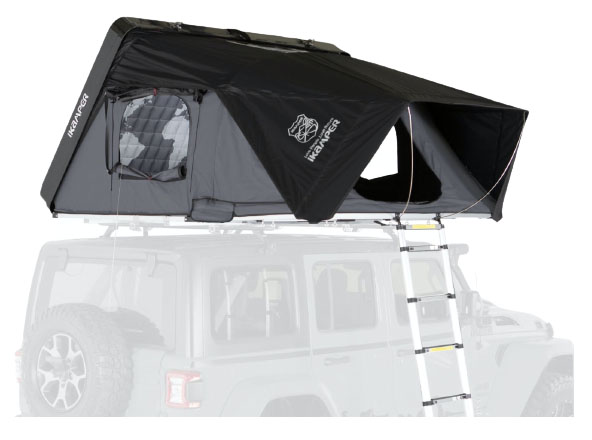 Category: Hardshell
Category: Hardshell
Floor area: 44.3 sq. ft.
Peak height: 48 in.
Available Capacities: 2, 3+
What we like: Premium build quality, quick setup, and wind-resistant design.
What we don’t: Much pricier than many other options in our lineup.
iKamper's first-generation Skycamp made waves during its debut in the spring of 2017 with a wildly successful Kickstarter campaign that surpassed its $100,000 goal by over $2.2 million. The first fold-out hardshell tent to hit the scene (a design now widely replicated by models like the Roofnest Condor above), the Skycamp became known for its durable construction, large floor plan, and patented 1-minute setup (unheard of for a softshell tent). Now in its third iteration, the 3.0 builds off the original formula with a redesigned mattress and windows, improved materials, and extras like a waterproof electronics port and pole storage. In addition, it also fits bedding inside when closed, which is a big boon for convenience. Added up, the Skycamp is one of the most premium designs here and a solid choice for those looking for the best rooftop tent money can buy.
With all that praise, why do we have the Skycamp 3.0 ranked mid-pack? In short, given that you can get the very comparable Condor 2 XL for less cash, we're just not sure the iKamper is worth the investment. What's more, the Roofnest features a shorter footprint that's better for smaller vehicles, along with crossbar compatibility in the latest version. But comparisons aside, it's hard to find much real fault with the newest Skycamp, which is remarkably well built and about as refined as it gets. The Skycamp 3.0 is also offered in a more durable and scratch-resistant Rocky Black Shell version, and for solo travelers or couples who don't need the extra-large mattress, the two-person Skycamp 3.0 Mini will save you some cash at $3,895.
See the iKamper Skycamp 3.0
 Category: Hardshell
Category: Hardshell
Floor area: 26.4 sq. ft.
Peak height: 56 in.
Available Capacities: 2, 2+, 3
What we like: Included cross bars and multiple accessory attachment points.
What we don’t: Not as aerodynamic as the Roofnest Falcon.
Among hardshell models, it doesn't get much more functional than Cascadia Vehicle Tents' Mt. Hood. It features an aluminum clamshell design that's incredibly easy to set up and offers better wind and rain protection than most softshell or pop-up tents. Inside, you get a plush 3-inch mattress, fabric-lined ceiling for extra insulation, and multiple storage pockets. But the outside is where this tent shines: Included cross bars accommodate extra gear like skis or a lightweight boat, while channels around the outside offer attachment points for a shovel, awning, shower, and more. And like all CVT models, the Mt. Hood is built with high-quality materials that hold up well to bumpy roads and night after night of use.
The Mt. Hood comes in three sizes, with the interior footprint ranging from 47 to 57 inches in width (length is standard at 81 in.). Compared to the Roofnest Falcon, the CVT is considerably heavier (192 vs. 140 lb. for the 2P) and slightly less aerodynamic (8.3 vs. 8 in.), although the latter difference is very minor, and both can accommodate bedding when packed up for easier setup and take-down. If you're in the Las Vegas or Salt Lake City areas, it's worth a visit to one of their showrooms (they can help with installation, too). Clamshells aren't as livable or versatile as other rooftop tent designs, but for no-frills convenience and four-season protection, the Mt. Hood is a premium option and well worth a look.
See the Cascadia Vehicle Tents Mt. Hood
 Category: Hardshell
Category: Hardshell
Floor area: 30.2 sq. ft.
Peak height: 39 in.
Available Capacities: 2+, 3+
What we like: Stellar ventilation; 360° windows; built-in venting fan; full blackout curtains; spacious interior; included mattress is more comfy than most RTTs.
What we don’t: Cargo nets can't hold much weight; ladder doesn't lock open; no weather protective awnings; velcro at doors is quite loud; very expensive.
Another stellar pick from the premium brand, James Baroud, the Odyssey is a top-shelf rooftop tent that stands out for its comfort, ventilation, and ease of use. With 360-degree windows, a spacious interior (30.2 sq. ft. of floor space and 39 in. of headroom), and a plush high-density mattress, it feels more like a mobile cabin than a car-top shelter. The three-layer fabric walls block out light, keep rain at bay, dampen noise, and fend off condensation, while a solar-powered fan adds airflow on stuffy nights. Setup is nearly effortless—just unclip four latches and let the gas-assisted struts do the work—and the aerodynamic shell keeps road noise to a minimum in transit.
That said, the Odyssey is undeniably pricey, and a few design quirks stand out. The storage nets don’t hold much weight, the ladder doesn’t lock open, and the Velcro closures on the doors can be noisy when you’re trying to slip out quietly at night. We also wish James Baroud had included protective awnings over the windows—currently, you have to close everything up during a rainstorm, which limits ventilation despite the built-in solar fan. Add in the hefty weight, and mounting can be a bit of a chore. But for those with the budget, the Odyssey delivers a level of livability and refinement that’s hard to match, making it one of the most comfortable and thoughtfully built rooftop tents on the market.
Read more: James Baround Odyssey review
See the James Baroud Odyssey
 Category: Softshell
Category: Softshell
Floor area: 27.4 sq. ft.
Peak height: 38 in.
Capacity: 2
What we like: Small footprint leaves space for bikes, boats, and other rooftop cargo.
What we don’t: Limited interior space.
One issue with most rooftop tents is that they're fairly limiting for campers who also want to bring large cargo such as bikes, surfboards, or a kayak. But Thule's Foothill offers a fantastic solution, with a two-person design that packs up to just 24 inches wide, which is about half the size of a typical 2-person model. Many other tents here—including the iKamper X-Cover and most of Roofnest's offerings—accommodate cargo on top of their hard shell (in most cases, you'll have to remove it when setting up the tent), but the Foothill is the first model we know of that leaves space for your standard mounting racks. The end result is a much more sustainable arrangement for those consistently packing extra fun on their rooftop.
Of course, there are inherent compromises in going with such a streamlined design. With a width of just 47 inches, the Foothill's mattress is one of the narrowest here, and the 38-inch peak height offers middling headroom (keep in mind that it slopes towards the walls too, whereas pop-up models maintain their peak height throughout). But at just 108 pounds and with pre-installed mounting rails, the Foothill is easy to get on and off, and its telescopic design makes for a simple setup. Because of the limited space we don't recommend it for most, but Thule's Foothill is nothing short of a game changer for adventure junkies and who love their gear.
See the Thule Tepui Foothill
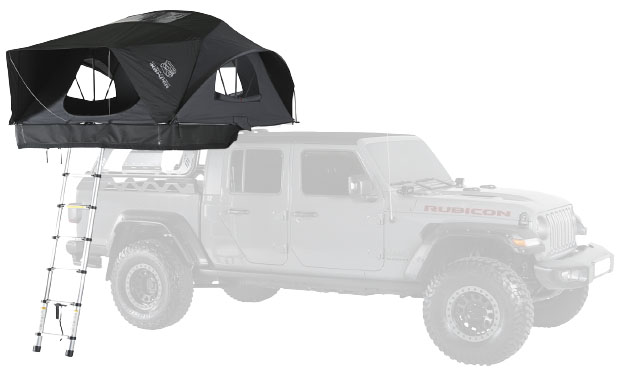 Category: Hardshell/softshell
Category: Hardshell/softshell
Floor area: 46.5 sq. ft.
Peak height: 48.75 in.
Available Capacities: 2, 3+
What we like: A well-executed hybrid design that costs and weighs less than the Skycamp above.
What we don’t: Takes longer to set up than most hardshells.
The Skycamp 3.0 above is iKamper's tried-and-true hardshell design, but the X-Cover 3.0 merges the performance benefits of a hardtop (including added durability and cargo-carrying capabilities) with the lightweight build and roomy mattress typical of softshells. To accomplish this, the X-Cover forgoes the fabric cover found on traditional softshell models and instead uses its own floor panel to serve as the hard cover, which folds over the tent and protects it when stowed. The result is an easy-to-pitch, versatile design that sleeps three to four people. And it doesn't hurt that iKamper has some of the best customer service out there—after a malfunction, one of our testers received a replacement ladder via express mail, and iKamper included a free awning for good measure.
If you’re deciding between iKamper’s Skycamp 3.0 and the X-Cover 3.0 here, there are a number of key differences to consider. The Skycamp is a true hardshell, and with that comes a quicker setup time and the added stability and weather protection of a fiberglass wall. The X-Cover, on the other hand, is cheaper, 37 pounds lighter (the newest 3.0 shaves 22 lbs. off the previous version), and can carry your bikes, boat, or surfboards on top (keep in mind you’ll have to remove all of your cargo before setting up the tent). And with the recent update, the X-Cover 3.0 has many of the same improvements as the Skycamp, including a new mattress and mattress cover, durable zippers, and the ability to leave your bedding inside during transport. Both are functional designs from one of the most respected brands in the business, and a final decision will come down to how you prioritize price, ease of setup, weather protection, and carrying abilities.
See the iKamper X-Cover 3.0
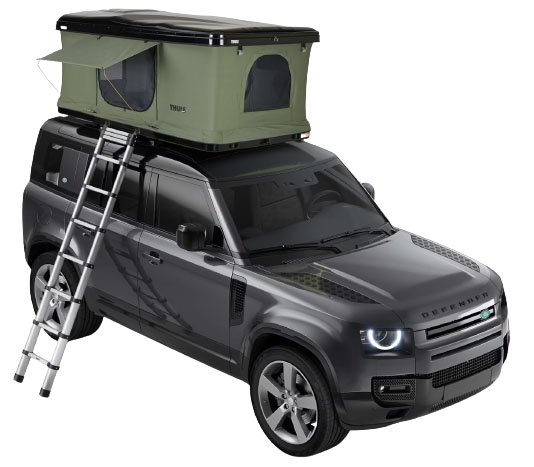 Category: Hardshell
Category: Hardshell
Floor area: 28.7 sq. ft.
Peak height: 37 in.
Capacity: 2
What we like: Rooftop tent and cargo box in one.
What we don’t: Heavier than some models here.
Thule's Basin is a hybrid design that is part rooftop tent, part cargo box. With the tent canopy installed, pop up the roof and you have a snug sleeping area for two, complete with a plush, 3-inch foam mattress and well-ventilated yet waterproof walls. When you need added storage space, unzip the canopy, take out the mattress, and use the Basin as a rugged rooftop gear tote to stash your skis or camping equipment (in this configuration, it opens up in a clamshell shape and features 23 cubic feet of storage). If you’re considering a rooftop tent but also value cargo space, the Basin is a nice compromise.
That said, the Basin is undoubtedly expensive, especially considering you can pick up the iKamper X-Cover above for considerably less, which features almost 20 square feet more space inside along with the ability to shuttle rack-mounted gear on top. But for a well-built product from a trusted brand, the Thule Basin fits the bill as another solid multi-purpose option. And Thule also offers the Basin in a "Wedge" version, which is similar to the model here but only opens in a clamshell configuration.
See the Thule Basin
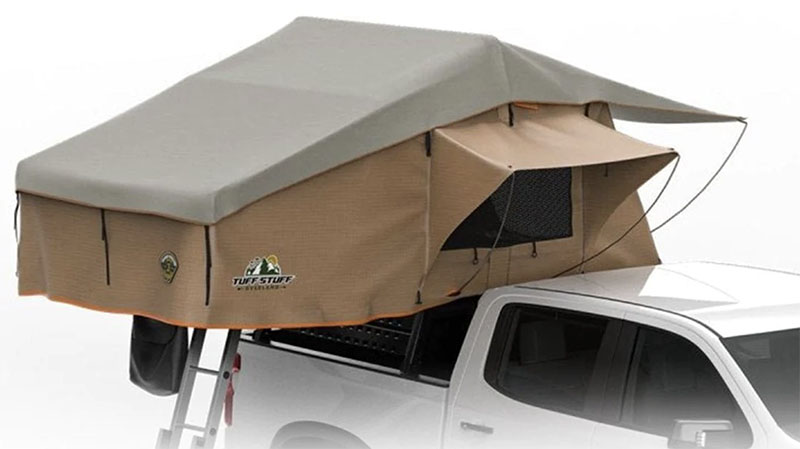 Category: Softshell
Category: Softshell
Floor area: 43.3 sq. ft.
Peak height: 52 in.
Capacity: 3
What we like: Annex and installation tools included in purchase.
What we don’t: Lacks the fit and finish of a Thule model.
Buying a rooftop tent is only the first step in kitting out your vehicle—you'll also need tools for installation, and many people add accessories like annexes and gear lofts later on. Tuff Stuff Overland is essentially a one-stop shop, and their Ranger 65 comes stock with all the necessary assembly and mounting tools, a hanging gear hammock, and even a storage bag for your shoes. At just $1,705 (tack on the annex for $370 more), that's a fairly good deal for a three-person tent, and we think of the Ranger as a great starter option for those who want to hit the road without all the hassle of buying parts and add-ons separately.
All that said, the Tuff Stuff doesn’t have the same polished and premium feel you get from Thule's softshells, nor does it come with the same range of customizations. In the end, you get what you pay for: Thule has a major leg up in quality. But Tuff Stuff is no slouch, and their overlanding products—which range from trailers to winches and truck bed racks—are great values. In the end, the Ranger 65 strikes a nice balance of functionality and affordability, which earns it a spot on our list. Tuff Stuff also offers a number of other softshell, clamshell, and fold-out hardshell options, from the rugged four-season Alpine to the hardshell Alpha.
See the Tuff Stuff Overland Ranger 65
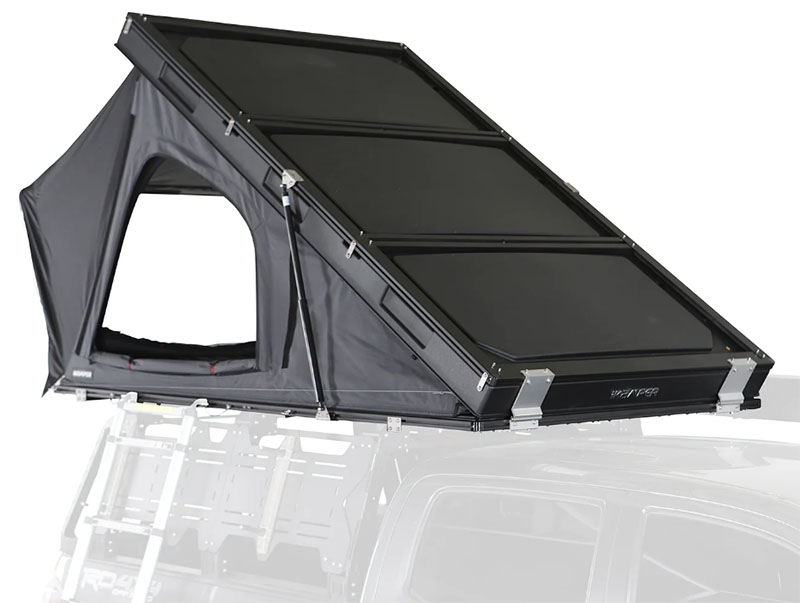 Category: Hardshell
Category: Hardshell
Floor area: 31.3 sq. ft.
Peak height: 59 in.
Available Capacities: 1, 2
What we like: High on value; low-profile design that accommodates cargo on top.
What we don’t: Unlike all-aluminum models, the BDV features a less durable fiber-reinforced plastic top.
iKamper became famous off the back of their Skycamp above, which was one of the first hardshell tents to extend the footprint past the roof of the vehicle. Their Blue Dot Voyager—or BDV for short—features a more traditional wedge design, but maximizes functionality with a durable aluminum base, super slim 6.75-inch-tall packed size, ladder mounts on three sides, and quick setup via two gas-powered struts. It’s also four-season ready with thick and snow-shedding materials (a wedge tent is also one of the most sturdy styles in heavy winds), and tacks on accessory rails for mounting extras like traction boards, solar panels, and cargo boxes (it can even handle 100 lb. on top when pitched). For a true utility tank of a rooftop tent, look no further than the iKamper BDV.
The BDV Duo goes head-to-head with the Roofnest Falcon above in terms of aerodynamics and utility, but it's considerably cheaper at just $2,795. With the drop in price comes a drop in durability: The iKamper uses an aluminum base and a fiber-reinforced plastic top, which isn't as durable as metal and is susceptible to sun damage. The BDV Duo also only comes in one two-person size, while the Falcon is available in two- and two-plus-person versions. Both are svelte and hardwearing rooftop tents for everything from gear-heavy weekend trips to overlanding, and your final decision will come down to space, price, and materials. Finally, iKamper offers a suite of BDV accessories, including an awning, insulated tent, accessory rack, solar panel, and more.
See the iKamper Blue Dot Voyager Duo
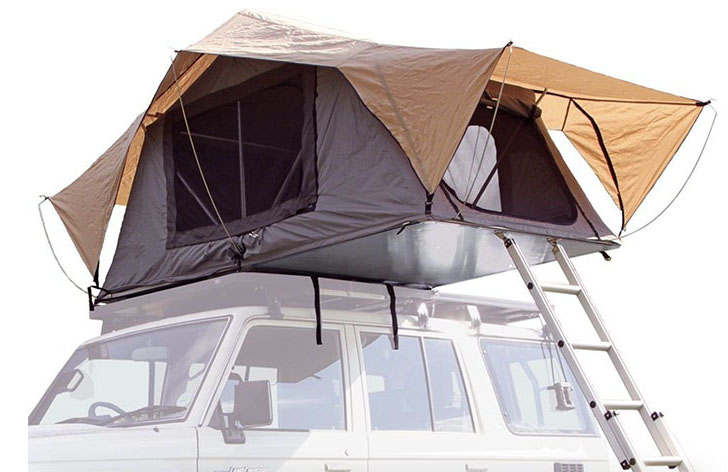 Category: Softshell
Category: Softshell
Floor area: 34 sq. ft.
Peak height: 46 in.
Capacity: 2+
What we like: Time-tested along South Africa’s rugged back roads; lightweight and easy to move.
What we don’t: Lacks the premium feel of the Roofnest Meadowlark above.
Off-roading is incredibly popular in South Africa, and therefore it comes as little surprise that Johannesburg-based Front Runner is well respected for their thoughtfully designed and robust overlanding products. Their 93-pound Roof Top Tent (formerly the Featherlight) is the lightest model on this list and a nice option for smaller cars, solo travelers, or those who plan to take their tent off their vehicle between trips. To make the loading and unloading processes even easier, Front Runner also sells their Quick Release Tent Mount Kit for an additional $149, which allows you to remove the tent quickly and without tools (it can also be paired with most other models here).
Despite its low weight, the Front Runner retains a durable body fabric (600D poly/cotton ripstop) and rainfly (400D polyester oxford), along with a reliable base and frame. Compared to the similarly intentioned Roofnest Meadowlark above, the Front Runner is just a few pounds heavier and features a sliding (rather than telescoping) ladder and thin mattress that lack the premium feel of the Roofnest. These gripes land it a bottom-of-the-pack finish, but it’s still a lightweight and functional rooftop design at a good price.
See the Front Runner Roof Top Tent
| Rooftop Tent | Price | Category | Floor | Peak Height | Weight | Capacities | Shell Materials |
|---|---|---|---|---|---|---|---|
| Roofnest Condor 2 XL Air | $3,995 | Hardshell | 42 sq. ft. | 50 in. | 170 lb. | 2+, 3+ | ASA/ABS plastic |
| Smittybilt Gen2 Overlander | $1,500 | Softshell | 35.1 sq. ft. | 51 in. | 154 lb. | 2+, 3+ | Softshell |
| Thule Approach Medium | $2,700 | Softshell | 33.6 sq. ft. | 40.2 in. | 128 lb. | 2, 2+, 3+ | Softshell |
| Roofnest Meadowlark | $1,595 | Softshell | 23.9 sq. ft. | 36 in. | 90 lb. | 2 | Softshell |
| Roofnest Falcon 3 Evo Air | $3,495 | Hardshell | 26.1 sq. ft. | 58 in. | 130 lb. | 2 | ABS/Aluminum |
| James Baroud Evasion | $4,295 | Hardshell | 30.2 sq. ft. | 39 in. | 145 lb. | 2, 2+, 3 | Fiberglass |
| iKamper Skycamp 3.0 | $4,199 | Hardshell | 44.3 sq. ft. | 48 in. | 165 lb. | 2, 3-4 | FRP (plastic)* |
| CVT Mt. Hood | $3,299 | Hardshell | 26.4 sq. ft. | 56 in. | 192 lb. | 2, 2+, 3 | Aluminum |
| James Baroud Odyssey | $4,895 | Hardshell | 30.2 sq. ft. | 39 in. | 143 lb. | 2+, 3+ | ABS plastic |
| Thule Tepui Foothill | $1,700 | Softshell | 27.4 sq. ft. | 38 in. | 108 lb. | 2 | Softshell |
| iKamper X-Cover 3.0 | $2,695 | Hybrid | 46.5 sq. ft. | 48.75 in. | 128 lb. | 2, 3-4 | FRP (plastic) |
| Thule Basin | $3,000 | Hardshell | 28.7 sq. ft. | 37 in. | 175 lb. | 2 | ABS plastic |
| Tuff Stuff Ranger 65 | $1,705 | Softshell | 43.3 sq. ft. | 52 in. | 164 lb. | 3 | Softshell |
| iKamper Blue Dot Voyager | $2,795 | Hardshell | 31.3 sq. ft. | 59 in. | 175 lb. | 1, 2 | FRP (plastic) |
| Front Runner RTT | $1,209 | Softshell | 34 sq. ft. | 46 in. | 93 lb. | 2+ | Softshell |
*Editor's note: FRP is short for fiber-reinforced plastic.
Rooftop tents (or RTTs for short) have become more popular over the last few years, and for good reason. While still no small feat to ship, assemble, and install, they are a more manageable camping alternative to trailers and large camper shells, which require larger vehicle payloads and towing ability—not to mention a deep wallet. But like these bigger options, RTTs allow you to stop and sleep practically anywhere you can park your car (considering local laws and ordinances, of course) without having to set up on the ground. The Switchback Travel team has been testing and writing about RTTs since mid-2020, and editor-in-chief Penney Garrett currently oversees this guide with the help of senior editor Chris Carter. Penney has been camping in all its forms for decades and loves to geek out on all the ways to make the process easier and more comfortable, especially in the beautiful Sierra Nevada mountains she calls home. Chris grew up in rural Kenya before moving to the States for college and knows a thing or twelve about how to travel and sleep in style—whether that means high on a rock wall on a portaledge or cozied up with his partner and dog in a rooftop tent.
Before settling on the 15 rooftop tents in this round-up, we did meticulous market research and tapped into the camping and overlanding community. Once we get these burly shelters in hand, we assess every component and seam, taking notes on each aspect of the assembly and installation process. After that, the fun begins. We've camped all over the western half of the US, from dense forests to expansive desert landscapes to Walmart parking lots. We pay attention to how each tent can handle wind, rain, and piercing direct sunlight, as well as how comfortable and private the interior space is and what potential upgrades each tent might have. A lot has evolved with these tents over the last several years, and we'll continue to update this guide as the choices change and improve.
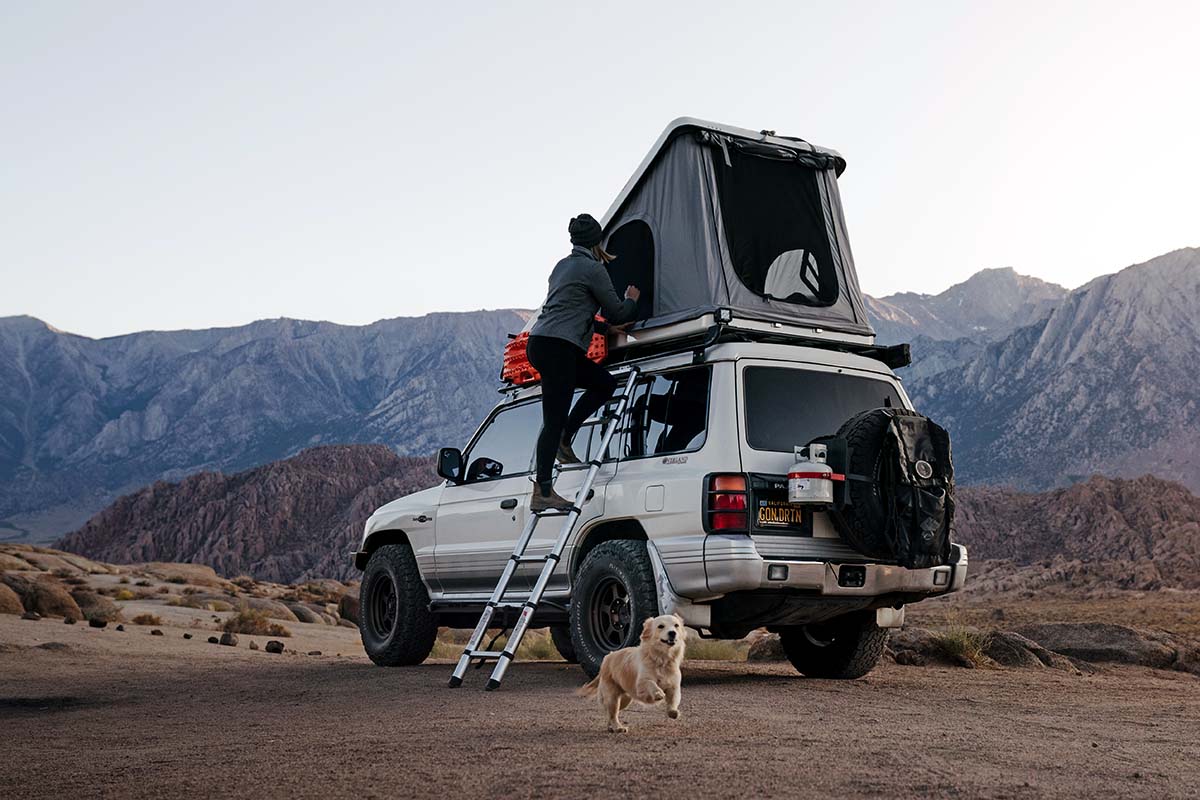
Softshell Tents
Most first-time rooftop tent shoppers opt for softshell models, and for good reason. These tents are covered with a burly waterproof soft cover and fold out beyond the roof of your vehicle. The tent body (usually made of canvas or nylon) is attached to the entire platform and sets up with the help of internal hinges and manually placed poles. The most obvious advantage here is price: Two-person softshells usually fall between $1,000 to $2,500, whereas a standard two-person hardshell tent will run you north of $3,000. Softshell tents also feature larger floor plans, come in a variety of shapes, and can easily accommodate annexes and awnings (more on this below).

However, when held up against hardshell models, the downsides are clear. First and foremost, the soft coverings are much more prone to moisture buildup (read: mold) when stored, resulting in a shorter lifespan. Additionally, without the stability of a hard cover, softshell tents are often noisier in the wind, both when opened and packed away. Finally, expect a softshell to take significantly longer to set up and take down, similar to a ground tent (most hardshells pop right up once you release the locks or latches).
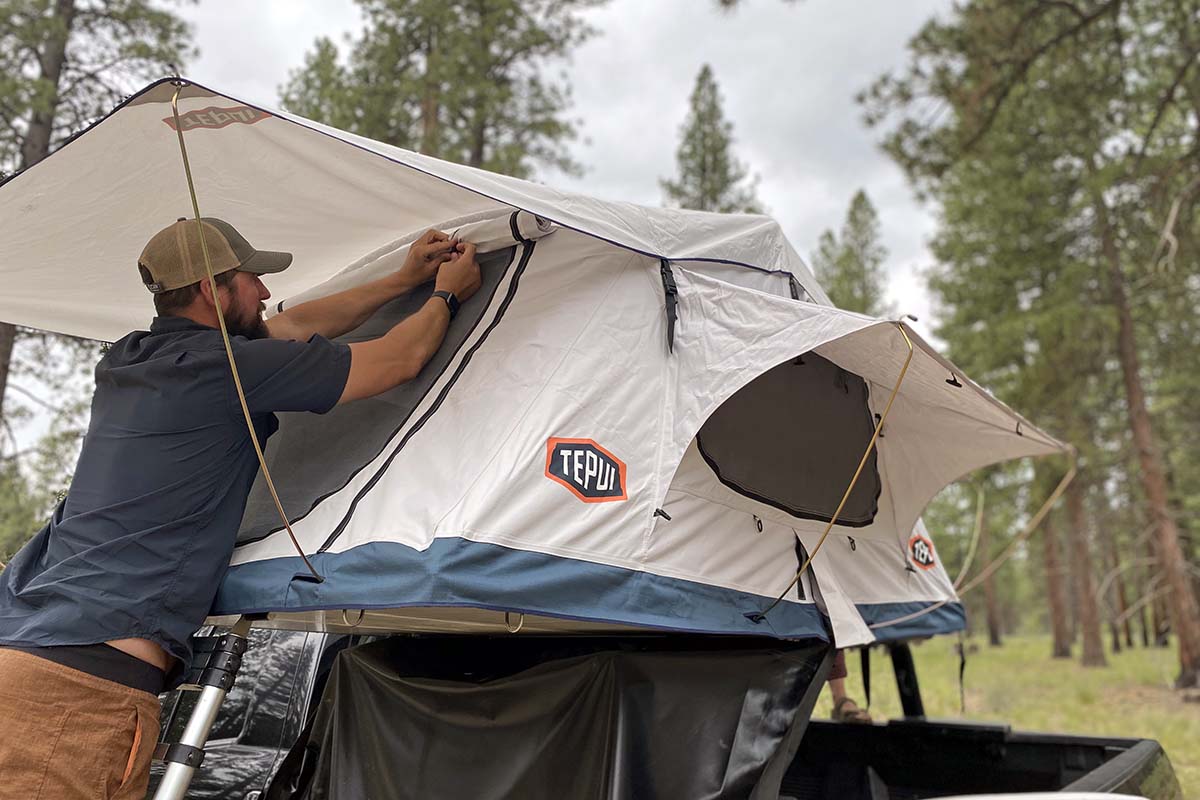
Hardshell Tents
Rather than using a soft cover, hardshell tents consist of a fiberglass, plastic, or aluminum shell that houses the fabric tent canopy inside. Most open either on a hinge (clamshells) or pop up on all sides (like a box). The majority of hardshells keep their footprint to the vehicle’s roof area, but a few (like the Roofnest Condor 2 XL Air and iKamper Skycamp 3.0) fold out, increasing the floor area and allowing you to add on extras like an awning.

Hardshell tents are significantly more expensive and heavier than softshells, and many feature smaller floorplans. However, their longer lifespan, added convenience, and superior protection are well worth it for many. During transport, hardshell tents are also more aerodynamic, completely waterproof (so mold is less of a concern), and protective against low-hanging branches and flying debris. Further, their shell-like design means they can often fit extra items like bedding inside, and some (like most of Roofnest's updated designs) are crossbar-compatible to accommodate bikes, skis, boats, surfboards, etc. When open, they’re far more wind-resistant, typically have more headroom, and are known for plusher mattresses. And one of the biggest draws to a hardshell tent is ease of setup, which often can be done by one person in under a minute. For campers who pack up and move camp every day, this is a big plus.

Like traditional camping and backpacking tents, rooftop tents come in a variety of capacities, from minimalist two-person models to massive designs that can accommodate up to six. The manufacturer’s recommended capacity is a good place to start, but take note: These specs are often rather generous. In the end, families with young children can likely get away with smaller floorplans, but many campers will choose to size up or opt for XL versions (an option with Roofnest’s tents). In our experience, the added comfort and livability are almost always worth the bump in price.
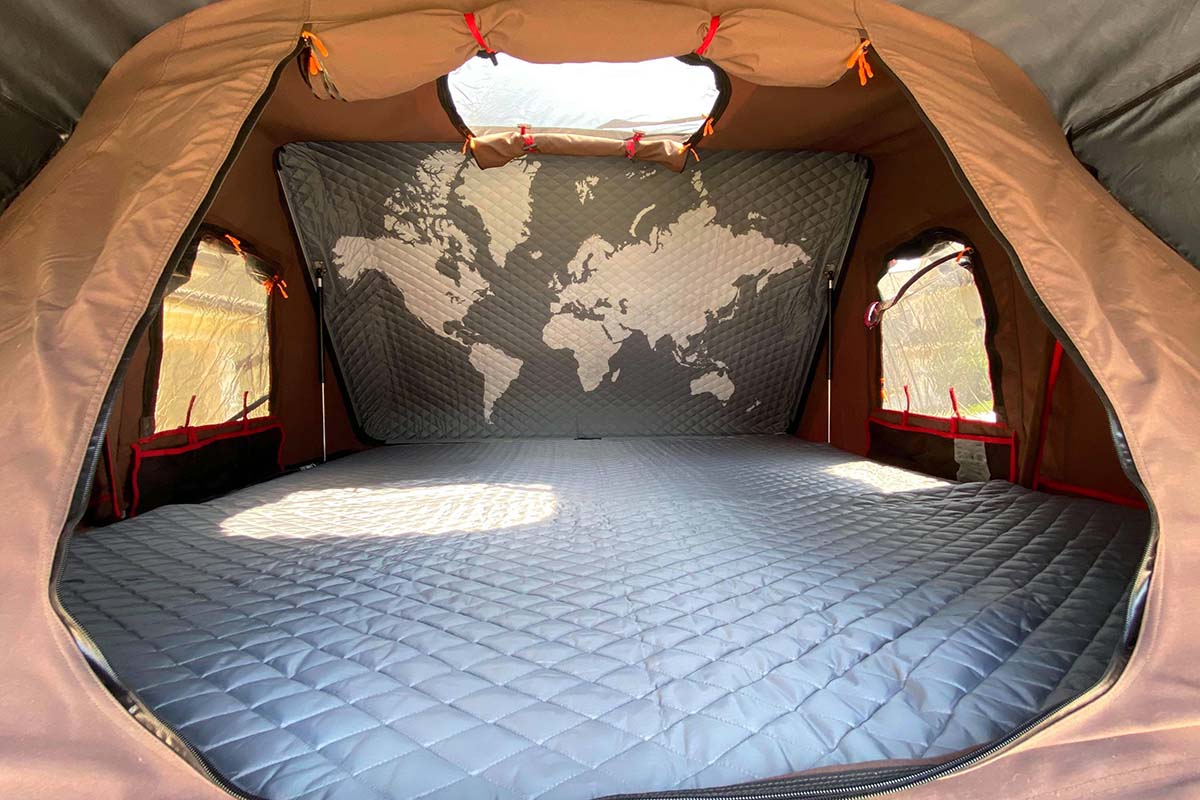
As we touched on above, a tent’s listed capacity and interior dimensions don’t always line up perfectly. Among the tents here in our lineup, mattress dimensions range from 47 by 84 inches (slightly narrower than a double mattress) to 87 by 96 (larger than a king-size mattress), with peak heights from 36 inches for Roofnest's Meadowlark to 59 inches for the iKamper BDV Duo. And keep in mind that a tent’s floor dimensions are not always the same as the size of the mattress. CVT's extended fly series, for example, features a larger floorplan, but the mattress dimensions are the same as what you get in the standard fly models. Finally, remember that peak height only specifies the highest point in the tent—box-like hardshells have a tall peak height throughout, while others, including clamshells and softshells, slope downwards from the highest point.
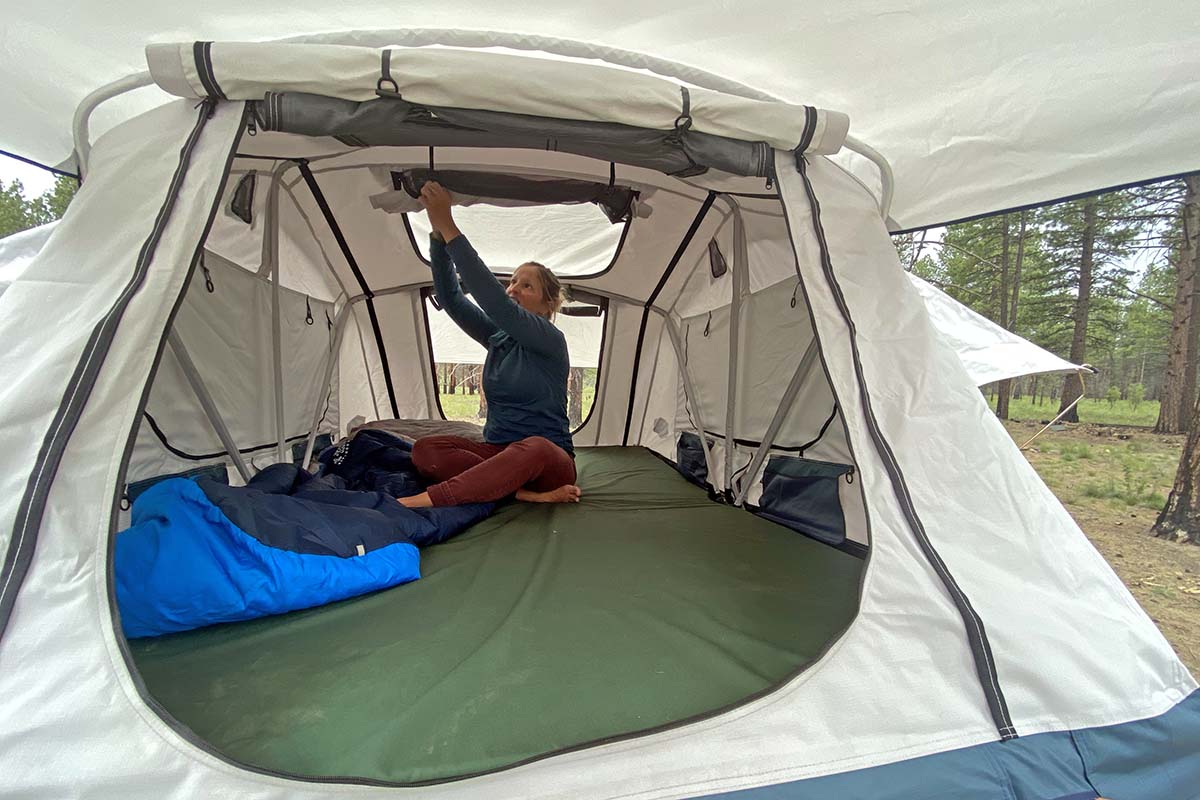
A key design feature and one of the biggest draws to rooftop tents is the integrated mattress, which runs the gamut from relatively thin 1.8-inch pads to plush 3.5-inch memory foam-topped beds. In determining comfort, you’ll want to look at the depth along with additions like a memory or gel foam topper, keeping in mind that clamshell or pop-top hardshell tents generally have the most premium options (they don’t have to fold to close up). Roofnest tents, for example, are known for comfort, whereas the budget-oriented Smittybilt Overlander’s mattress is thinner and stiffer. Finally, keep in mind that some manufacturers offer mattress upgrades.

In addition to mattress thickness and type, you’ll also want to consider a mattress cover and anti-condensation mat. Most mattresses come with removable covers for easy laundering, which vary in terms of water resistance, breathability, and comfort. In our opinion, your best bet is to opt for a protective cover (waterproof/breathable) and supplement with a sheet set (brands like Thule sell custom-sized sheets or you can make do with a standard bed sheet set). Further, many tent designs incorporate an anti-condensation mat underneath the mattress to mitigate moisture buildup and mold (these can also be purchased separately). That said, it’s always a good idea to remove your mattress between trips or prop it up on its end during the day to dry out the underside and allow it to breathe.
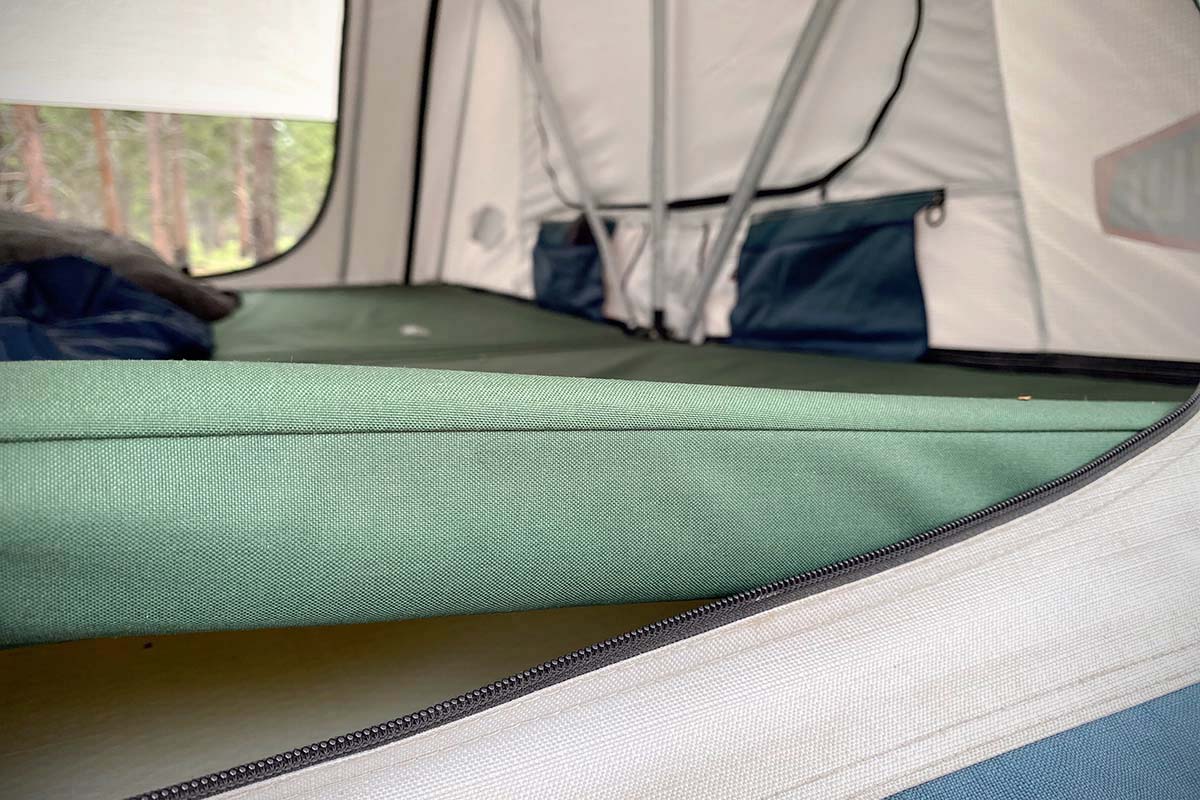
In general, rooftop tents are constructed with burly materials that can withstand frequent use and abuse. Concessions rarely are made for weight savings—expect to find ultra-thick fabrics and robust zippers (for example, Thule's Approach has 600-denier walls compared to the 75D fly fabric on a popular camping tent like the REI Co-op Wonderland 4). In addition to fabrics, the metal components are built to last, and the floors are designed to handle serious weight.
Despite the impressive overall build quality, the biggest threat to rooftop tents is exposure. Unless you’re removing your tent from the roof of your vehicle between each outing, it’s bound to suffer sun and moisture damage over time. Most softshell tents come with a protective cover, but it’s still a good idea to look for thick UV- and mold-resistant fabric, sealed seams, and a heavy-duty aluminum base to guard against branches and rocks. If and when your softshell does need replacing, most models use zippers to attach the tent canopy to the frame, so you can replace the canopy without buying an entirely new setup.

Hardshells fare much better than softshells, with secure waterproof exteriors that can stand up to the elements more effectively than canvas or nylon covering. But not all hardshells are created equal: Our list above features examples of everything from ABS and fiber-reinforced plastic shells to those built with honeycomb and extruded aluminum. Plastic is particularly vulnerable to sun damage, which can cause cracking and degradation over time. It also can break under pressure, and, as such, isn’t our first choice for traveling bumpy jeep roads. If you explore off the beaten path or leave your rooftop tent on your vehicle all year, we strongly recommend an all-metal design like the Roofnest Falcon, or at minimum, a tent with a fiber-reinforced plastic shell (like those from iKamper). And if sun exposure is the only concern, you can hedge your bets with a UV-resistant cover: Roofnest offers covers specifically sized to various models, and you can purchase custom designs from a website like Covers and All.
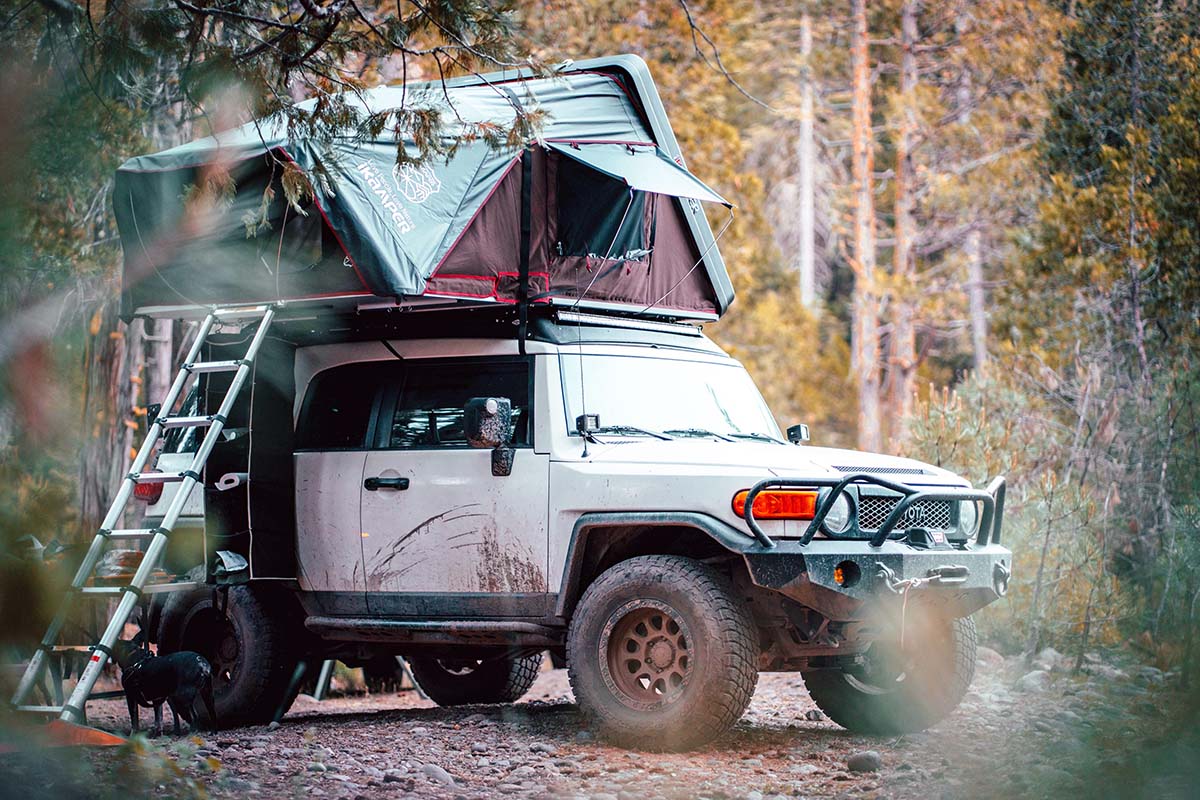
Rooftop tents are built to withstand the elements, with thick, water-resistant body fabrics (usually a polyester cotton blend) and fully waterproof rainflys. If you plan to use your tent in inclement conditions, be sure to look for full-coverage awnings on all the windows and doors so you can keep air flowing without allowing moisture in. Pop-top and clamshell models like the James Baroud Evasion and CVT Mt. Hood use their shells as roofs, with clamshells providing the strongest structure (as long as you park with the shell towards the direction of the wind) and a quieter sleep in blustery conditions. In fact, one of our testers upgraded to a hardshell because he'd grown so tired of his softshell flapping in the wind.
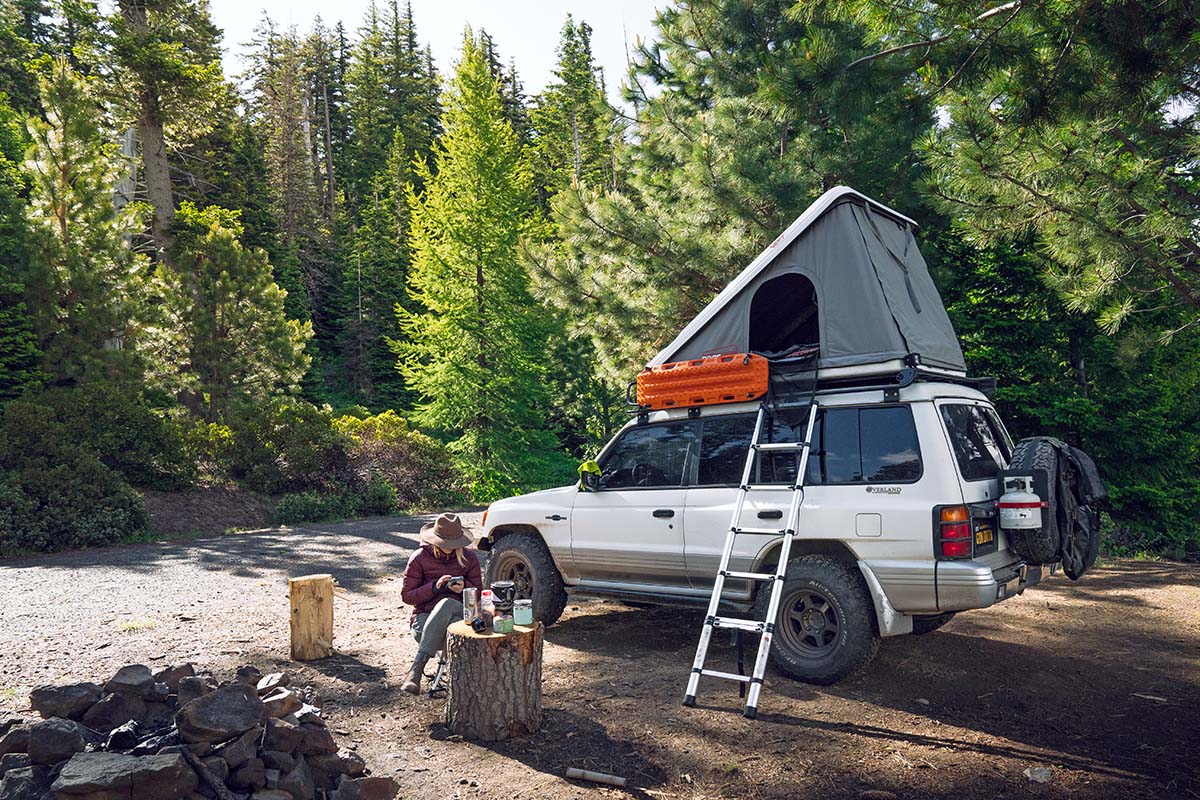
In addition to protection against wind and rain, some rooftop tents come with the option to add extra insulation, like iKamper’s Inner Insulation Tent and Thule's Insulator. If you’re used to sleeping outside, have a warm sleeping bag, or plan to camp only in the summer months, additional insulation probably isn’t necessary. But for those who get outside year-round or frequently sleep at elevation, these inserts can add a nice dose of warmth on cold nights.
In general, rooftop tents are great breathers. Because air flows underneath the tent and your vehicle, they ventilate better than standard ground tents. Most models also come with generous windows and mesh panels, many of which can be completely unzipped or closed with just a bug net and are protected by waterproof awnings. Additionally, manufacturers often add anti-condensation mats underneath a hardshell's roof or under the mattress, minimizing pesky drips in the middle of the night and mold buildup (these also add another layer of insulation).
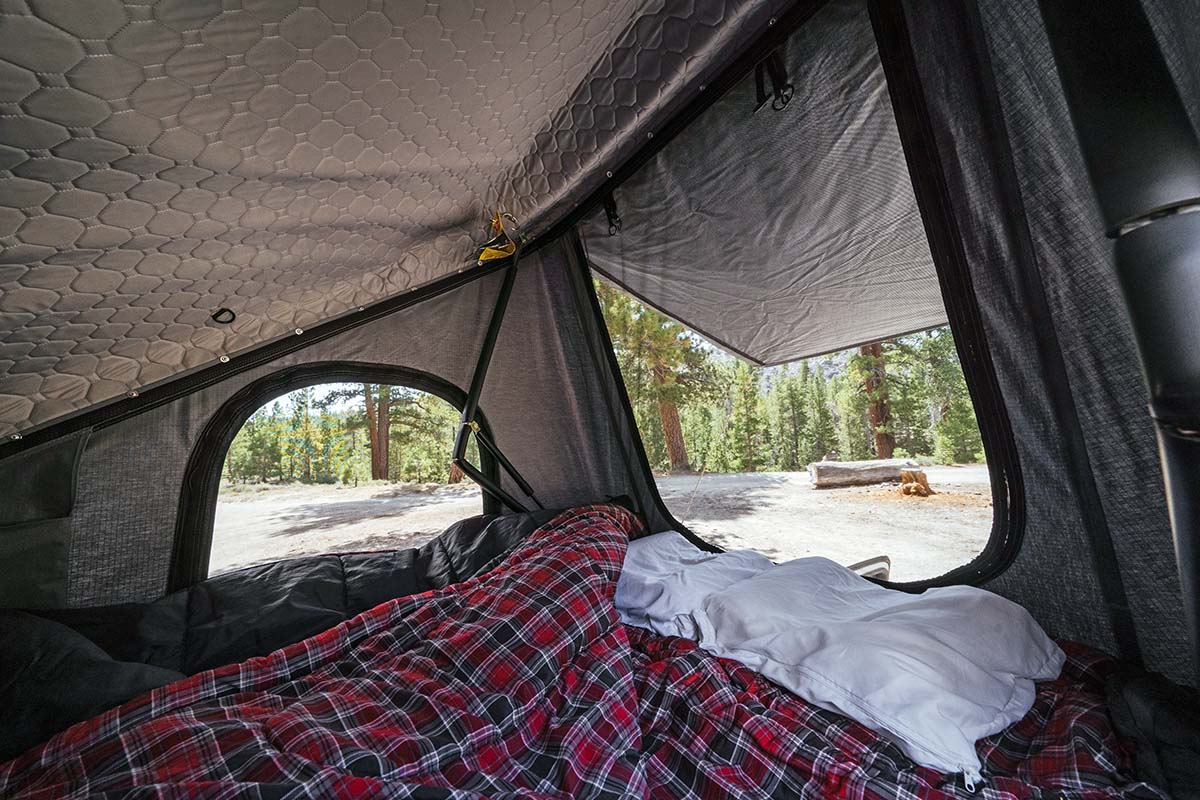
If ventilation is a top priority, we recommend looking for a tent with a breathable body fabric, full-coverage rainfly (or insulated hard top), and enough space between the two for air to flow. We love iKamper’s tents, but many users complain that they don’t vent well due to the lack of space between the body and fly (you can always roll back the fly on dry nights). Regardless of which tent you choose, it’s best to sleep with the windows and vents open to encourage airflow and minimize the accumulation of condensation overnight.

In general, rooftop tents are far more convenient to set up than pitching a standard ground tent. However, there are some key differences between models. Hardshell tents are the speediest to assemble—it’s often as simple as unclipping the shell, engaging the hinges, and watching the roof rise. Even a more complex hardshell like the iKamper Skycamp 3.0 can be set up in a minute. On the other hand, softshell tents require a bit more time to remove the soft cover and insert poles to prop up the fly and awnings. Take down is just a matter of reversing the steps, although you’ll want to be careful to ensure that all of the tent fabric is safely inside the shell or cover.
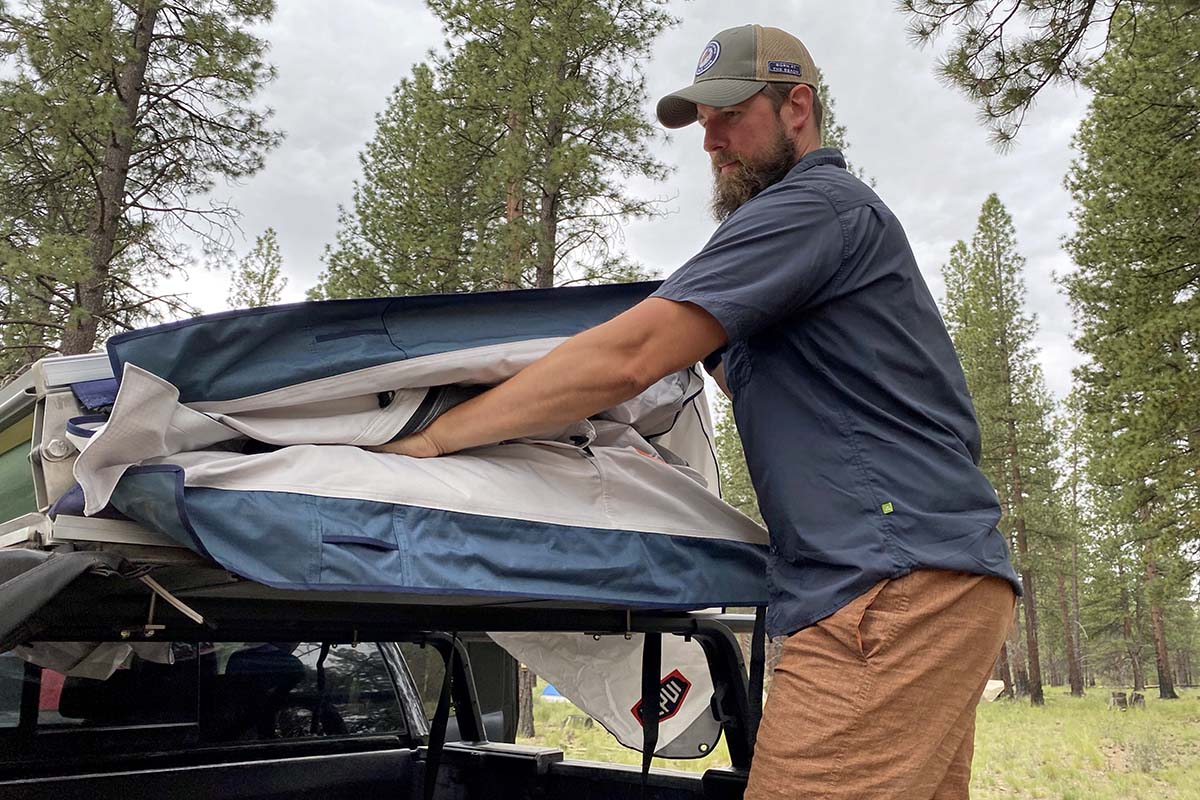
Recreational campers or those who plan to use their rooftop tent only occasionally may not be bothered by the extra time it takes to set up and take down a softshell tent. However, frequent travelers and avid overlanders (especially those who pack up and move camp daily) will appreciate the convenience of a hardshell’s easier setup. A few minutes might not seem like much, but it adds up quickly. And if you’re adding an annex or separate awning (see our section on “Annexes and Awnings” below), it goes without saying that your setup will take longer and be more involved. In general, these are great systems for those who plan to stay parked for two or more nights, but we don’t recommend them for campers who pack up and move each day.

The packed size of rooftop tents varies widely, but it's a good rule of thumb to keep the footprint of your tent within your roof's dimensions—and those with small cars or trucks should be especially careful before making a purchase. Packed height also is a highly variable factor and can heavily impact gas mileage and noise while driving (and remember to factor in the added height when going under bridges, entering parking garages, etc.). If you're concerned about this and want a low-profile design, we recommend going with a model like the sleek and aerodynamic Roofnest Falcon 3 Evo Air, which measures only 8 inches tall when closed. Most manufacturers list the closed dimensions of each tent on their product page, and it's a worthwhile spec to dig into before buying.
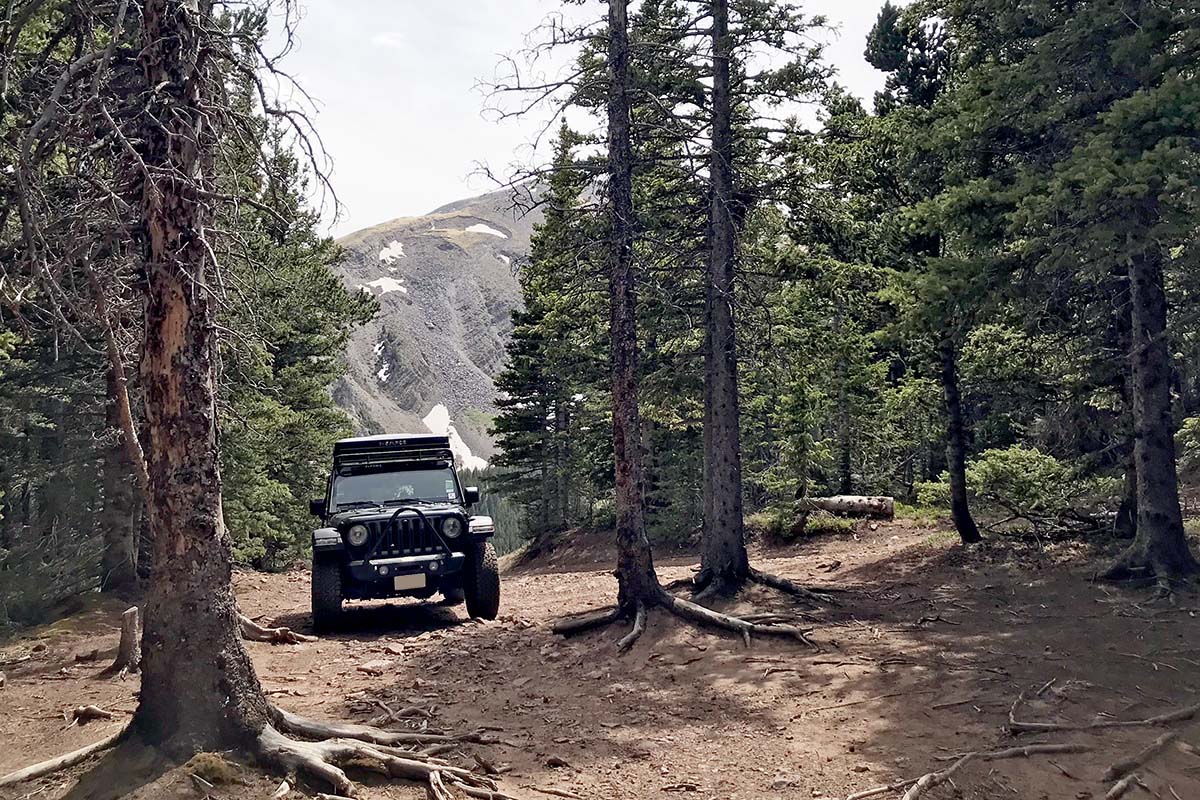
Without a doubt, rooftop tents are heavy and bulky pieces of gear. On our list above, weight ranges from 93 pounds for the "minimalist" Front Runner Roof Top Tent to a whopping 192 pounds for the CVT Mt. Hood (the size-large Mt. Hood is 214 lb.). Because of their heft and bulk, these tents are not easy to install or take off and generally will take at least two people to mount or remove from your vehicle.

However, the most important reason to consider weight has to do with your vehicle’s handling and hauling capabilities. All vehicles have a rooftop load limit specified by the manufacturer (most cars and SUVs max out at 160 lb.), which we recommend considering for a few reasons. A top-heavy load drastically affects your vehicle’s center of balance, and overloading your suspension can have lasting implications. Further, gas mileage will suffer with a heavier load. And the load limit is especially important to keep in mind if you’re planning on putting gear on top of your tent, as you might with the iKamper X-Cover 3.0. In the end, we advise looking closely at these specs before buying—you’ll want to be clear on your vehicle’s rooftop capacity (both static and dynamic) and remember to also factor in the weight of the rack, your bedding, and any additional gear.
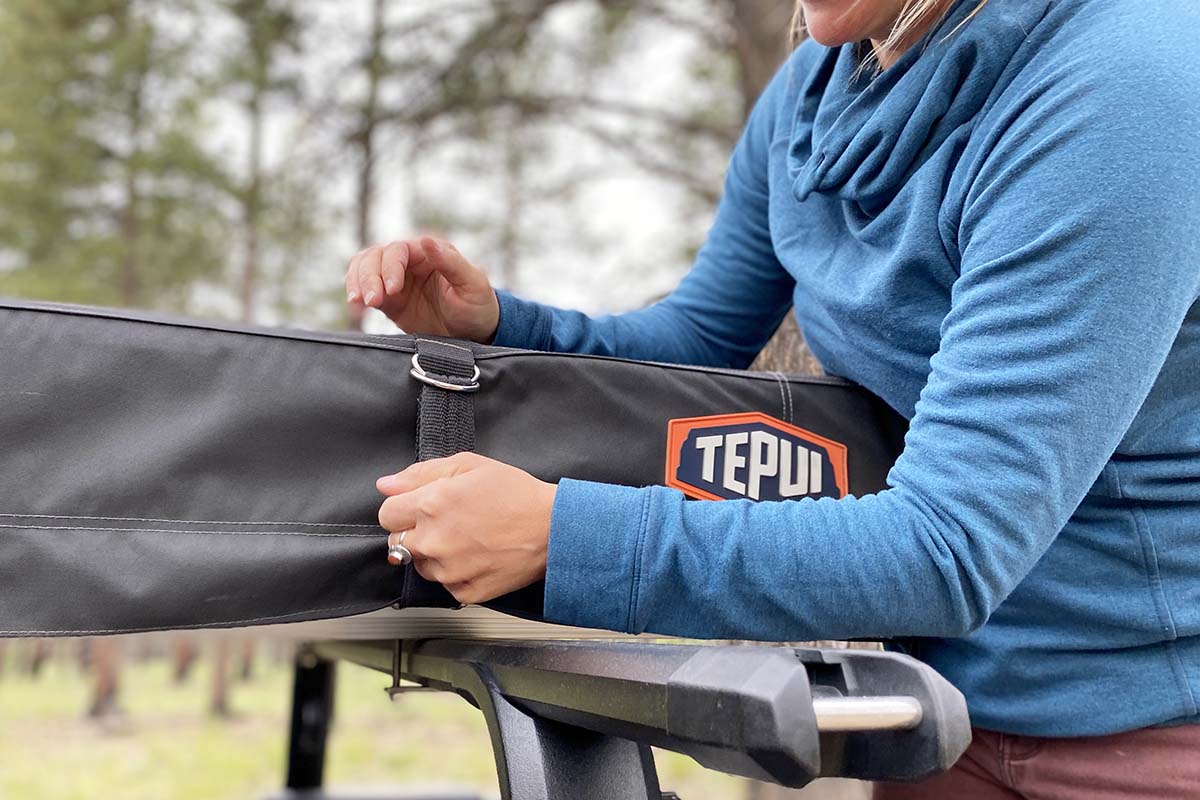
Most rooftop tents come with a fairly standard feature set that includes an aluminum ladder (sliding or telescoping), window awnings, and a hanging gear hammock. But premium models don't stop there. Many designs above sport features like LED lighting, USB ports, and shoe bags. Verging on luxury, James Baroud's offerings include a solar-powered ventilation fan complete with air vents and dust filters. If you stick with the base models, you still have the option of tacking on extra items to your purchase. Rooftop tent brands like Thule and iKamper, for instance, sell additions like shoe racks, sheet sets, anti-condensation mats, inner insulation tents, and even retrofit canopy windows.

If you're camping for an extended period, an annex or awning is a great way to increase livable space while maintaining privacy and protection from the elements, including sun, rain, and bugs. Annexes attach to the tent's extended platform and create an enclosed area underneath, which can be a great place for a portable shower or toilet, camp kitchen, or additional living space. The majority of annexes also enclose the ladder, creating a nice downstairs/upstairs feel. Awnings, on the other hand, are simple roofs that extend out from your tent and prop up with poles to create an open area that provides shade and additional coverage.
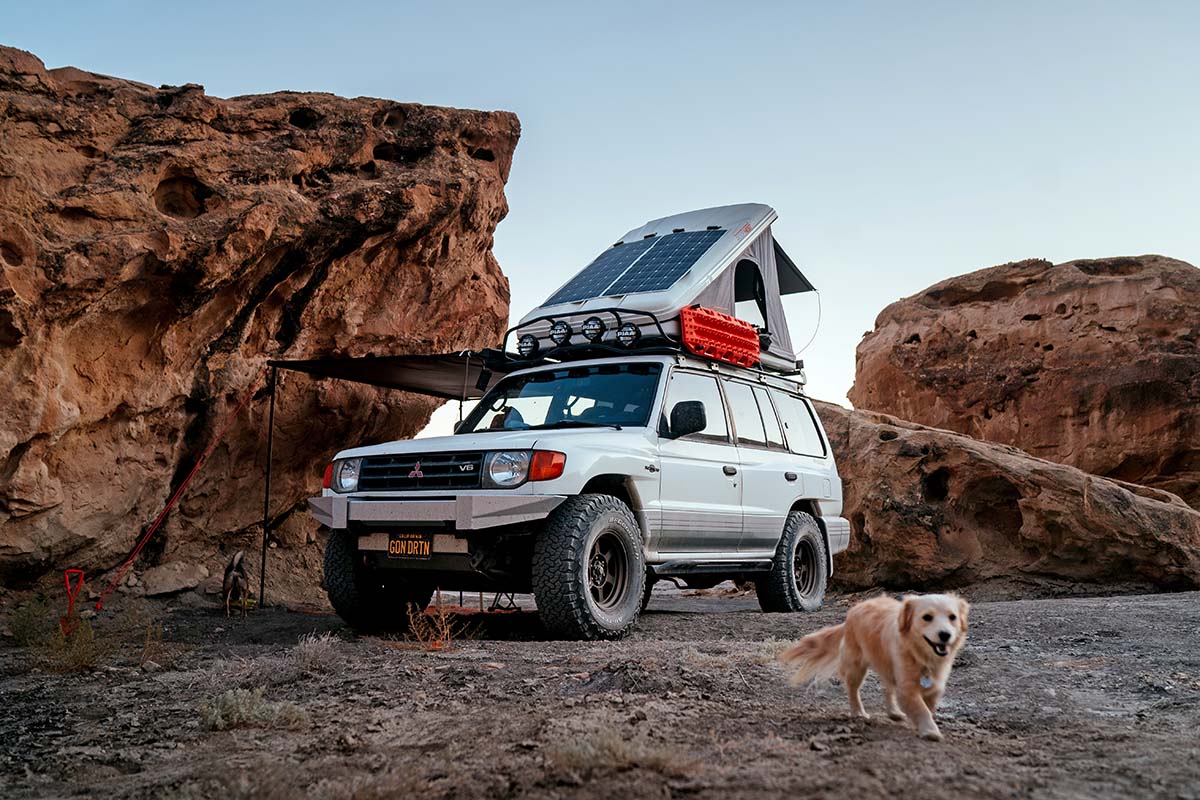
Some annexes or awnings come with the purchase of a tent, but most are sold separately. If you’re purchasing your tent and annex separately, you’ll want to make sure they’re compatible. Most share the same name to make things easier, and manufacturers also typically list which tents are compatible with which accessories. Finally, it’s important to keep in mind that annexes cannot be paired with pop-up or clamshell tents that don’t fold out beyond the footprint of your vehicle (with the exception of James Baroud's enclosed awning), so if you expect to add one later, make sure you’re getting the appropriate style tent.
If you like to bike, ski, paddle, or surf, you have a few different options for toting your extra gear along with a rooftop tent. First off is the Thule Foothill, which measures just 24 inches wide and leaves approximately half of your rooftop available for standard racks and gear. If you want a bit more sleeping space (the Foothill is fairly limited at around 27 sq. ft. of floor area), you might consider a rooftop tent with external storage compatibility. There are now a number of hardshells that include crossbars (like the iKamper X-Cover 3.0 and Roofnest Falcon Pro) or are crossbar-compatible (including the iKamper BDV and Roofnest's Condor series), which means you can easily affix your boats, skis, surfboards, and bikes to the top of your vehicle. And we'd be remiss not to mention Thule's Basin here, a pop-up hardshell designed with a removable mattress and zip-off fabric walls that allow it to double as a cargo box for gear storage. In other words, no need to alternate between mounting your tent or cargo box on your car each weekend.
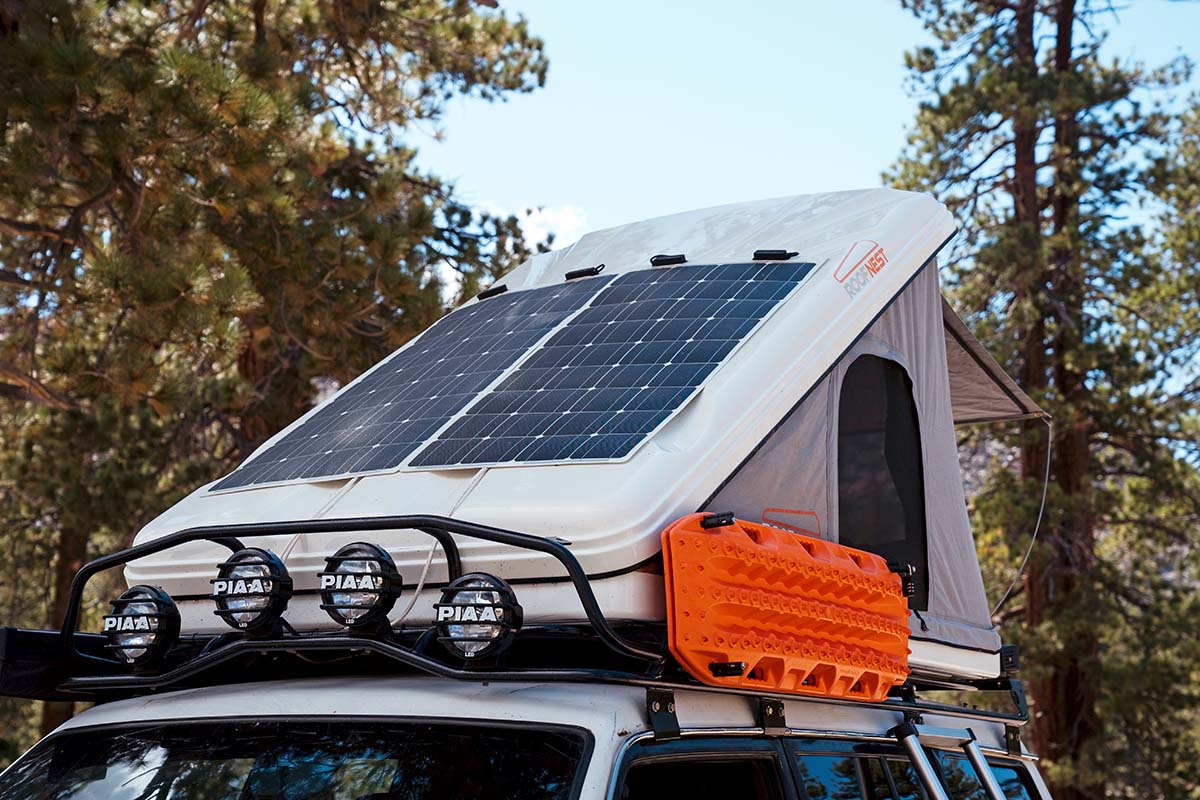
Regardless of what kind of rooftop tent you choose, there are steps you can take to extend its lifespan. Most importantly, you’ll want to make sure the tent is fully dried out after each trip and store it in a dry, shaded area, just as you would with a standard tent. We also recommend regularly propping up the mattress so that the base of the tent has a chance to air out. If grime gets into the fabrics or zippers, it can degrade them quickly, so routine cleaning using mild dish detergent and warm water is a good idea. Finally, if your rainfly or tent walls stop repelling water and you need to revive the waterproofing, we’ve found that a marine-grade spray-on protector like Star Brite’s waterproofing spray works best.

Most rooftop tents come with a warranty, generally ranging from one to five years. Warranties vary depending on the company and are usually only available to the original buyer. Given the nature of rooftop tents—expensive and built for heavy use—a good warranty might be an important factor in your purchase. Online forums and reviews can be helpful in assessing which companies offer the best customer service. In particular, we've heard glowing reports from our testers regarding iKamper, James Baroud, and Roam's customer service and warranty programs.
Before you purchase a rooftop tent, you'll want to be sure you have the right vehicle for the job. In general, if your car, truck, SUV, or van can be paired with a roof rack, chances are you'll be able to attach a rooftop tent. Some vehicles come with factory roof racks already installed, but many are aftermarket additions from companies like Thule and Yakima. The first step is to purchase a rack that is compatible with your vehicle (many manufacturer websites make this fairly simple with interactive fit tools, like Thule's "Select your vehicle" function on each product page). Next, you'll want to be sure your rooftop tent fits the rack. The good news is that this is a lot less complicated than it sounds: Most rooftop tents are highly adaptable and come with a range of adjustments and available adaptors. For a great breakdown, check out Roofnest's Roof Rack Guide here.

There are a few other factors to consider regarding vehicle compatibility. As mentioned above, all vehicles come with static and dynamic load ratings, limiting the weight of a compatible tent. If you have a car, small truck, or SUV, this is especially important to know beforehand (for example, the 192-lb. CVT Mt. Hood can only be installed on larger vehicles). You'll also want to think about mounting location: Rooftop tents can be affixed to your roof, over your truck canopy or empty truck bed, on a trailer, or even on a hitch rack (freeing up your rooftop for other gear).
Once you've made sure that your rooftop tent is compatible with both your vehicle and your rack, you're ready to load it on top (again, we recommend at least two people for the job). In our experience, the most user-friendly tents are those made by rack companies (Thule and Yakima in particular) that are compatible with specific racks—you can purchase the rack and tent at the same time and know you're getting a pair that works together. Other designs will require a bit more DIY savvy to install (YouTube videos are very helpful) and likely a few trips to the hardware store. Again, purchasing from a local gear shop will typically alleviate some of the headaches, as many shops will be able to help load your tent onto your vehicle.

Given that rooftop tents are such a large investment, we recommend going into your local retailer or gear shop and comparing various models before making a decision. Simply put, there's no substitute for being able to hop in a tent and get a feel for the overall build and dimensions. Most REI Co-op stores have a selection of Thule and iKamper tents, and you can also find models for sale at rack, vehicle accessory, or overlanding stores. Another advantage to shopping in person is that there's a good chance most brick-and-mortar retailers offer installation services. But there's no denying the deals you can find online, and most of the rooftop tents listed here can be purchased from the comfort of your home. Shipping fees might offset your savings (REI Co-op charges $160), but some retailers ship free of charge, including Thule, iKamper, Roofnest, and 23Zero. If you know which model you want to buy and don't have to pay an arm and a leg for shipping, buying online isn't a bad idea.

Not only do rooftop tents allow you to turn practically any vehicle into a camper and free up valuable storage space inside, but they're more comfortable than a standard camping tent, far easier to set up, and they keep you off the ground. But before you make such a big investment, it's important to consider the downsides: Rooftop tents are expensive, will impact gas mileage and handling of your vehicle, and are heavy pieces of gear that are onerous to move around. Further, unlike a ground tent, you'll have to pack up camp every time you choose to move your vehicle, and getting in and out via a ladder can get old quickly. In the end, it's important to evaluate your camping preferences and needs. If convenience and comfort are the biggest factors and you're less worried about the logistics of carrying it on your car, a rooftop tent makes a lot of sense.
Back to Our Top Rooftop Tent Picks Back to Our Rooftop Tent Comparison Table